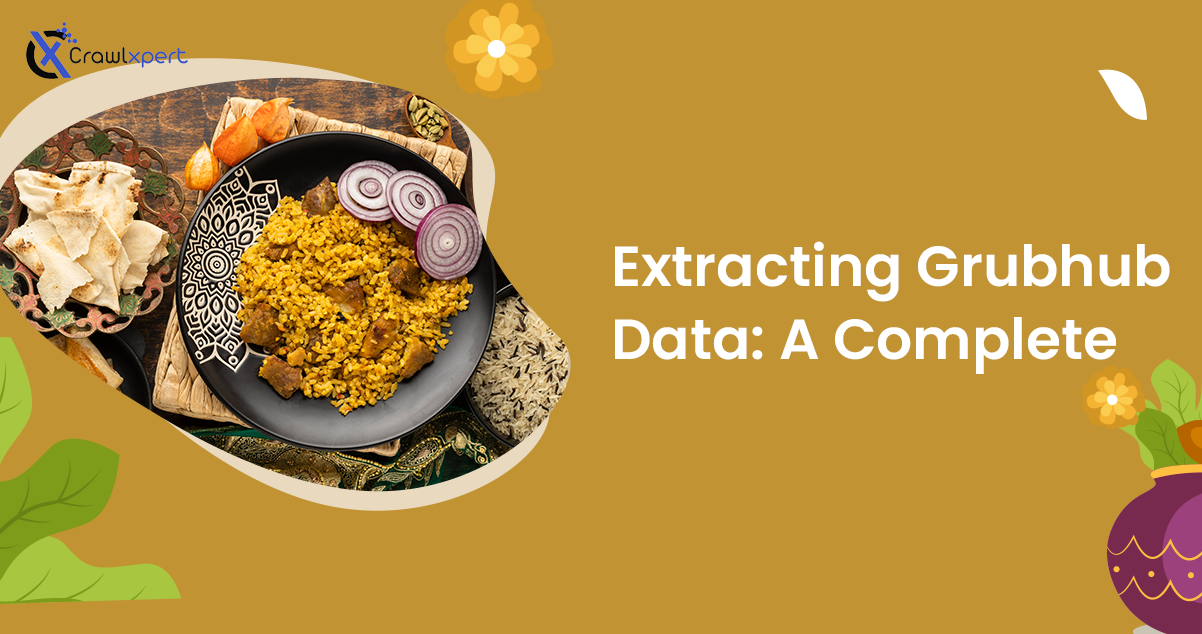
Extracting Grubhub Data: A Complete Web Scraping Guide
Apr 14, 2025
Introduction
Data is a very essential aspect of the food delivery service and has become important for a company trying to gain an edge over the competition. The web scraping Grubhub Delivery Data will allow businesses, researchers, and analysts to glean knowledge about restaurant listings, menu prices, customer reviews, and delivery times. Grubhub Data Scraping will help businesses keep track of market trends, refine price strategies, and improve customer service.
This guide contains everything you need to know on how to Scrape Grubhub Food Delivery Data well; it also contains the best-devices, techniques, legal considerations, and problems involved. Whether you are a businessman, data analyst, or developer, this guide should prove very handy in extracting and analyzing Grubhub data.
Why Scrape Grubhub Data?
- Comprehensive Market & Competitive Study: Grubhub data is employed to scrutinize the competitors' payment receipts, menus, and customer likes.
- Restaurant Performance: Grubhub Data Analysis aids restaurants in evaluating their settings, reviews, and overall customer satisfaction against competitors.
- Determination of Menu Pricing: Information on menu pricing between various restaurants may allow businesses to opt for their own pricing, achieving a more competitive strategy.
- Customer Review & Sentiment Analysis: Scrape customer reviews to analyze consumer preferences, complaints, and trending menu items.
- Delivery Timeliness & Service Efficacy: Data on estimated delivery time could help improve logistics and operability.
Legal & Ethical Considerations in Grubhub Data Scraping
Before scraping data from Grubhub, it is crucial to ensure compliance with legal and ethical guidelines.
Key Considerations:
- Respect Grubhub’s robots.txt File – Check Grubhub’s terms of service to determine what content can be legally scraped.
- Use Rate Limiting – Avoid overloading Grubhub’s servers by controlling request frequency.
- Ensure Compliance with Data Privacy Laws – Follow GDPR, CCPA, and other applicable regulations.
- Use Data Responsibly – Ensure that extracted data is used ethically for business intelligence and market research.
Setting Up Your Web Scraping Environment
To efficiently extract Grubhub Data, you need the right tools and setup.
1. Programming Languages
- Python – Preferred for web scraping due to its powerful libraries.
- JavaScript (Node.js) – Useful for handling dynamic content loading.
2. Web Scraping Libraries
- BeautifulSoup – Ideal for parsing static HTML data.
- Scrapy – A robust web crawling framework.
- Selenium – Best for interacting with JavaScript-rendered content.
- Puppeteer – A headless browser tool for advanced scraping.
3. Data Storage & Processing
- CSV/Excel – Suitable for small datasets.
- MySQL/PostgreSQL – For handling structured, large-scale data.
- MongoDB – NoSQL database for flexible data storage.
Step-by-Step Guide to Scraping Grubhub Data
Step 1: Understanding Grubhub’s Website Structure
Grubhub loads its content dynamically through AJAX calls, meaning traditional scraping techniques may not be sufficient.
Step 2: Identifying Key Data Points
- Restaurant names, locations, and ratings
- Menu items, pricing, and special discounts
- Estimated delivery times
- Customer reviews and sentiment analysis
Step 3: Extracting Grubhub Data Using Python
Using BeautifulSoup for Static Data Extraction
import requests
from bs4 import BeautifulSoup
url = "https://www.grubhub.com"
headers = {"User-Agent": "Mozilla/5.0"}
response = requests.get(url, headers=headers)
soup = BeautifulSoup(response.text, "html.parser")
restaurants = soup.find_all("div", class_="restaurant-name")
for restaurant in restaurants:
print(restaurant.text)
Using Selenium for Dynamic Content
from selenium import webdriver
from selenium.webdriver.common.by import By
from selenium.webdriver.chrome.service import Service
service = Service("path_to_chromedriver")
driver = webdriver.Chrome(service=service)
driver.get("https://www.grubhub.com")
restaurants = driver.find_elements(By.CLASS_NAME, "restaurant-name")
for restaurant in restaurants:
print(restaurant.text)
driver.quit()
Step 4: Handling Anti-Scraping Measures
- Use rotating proxies (ScraperAPI, BrightData, etc.).
- Implement headless browsing with Puppeteer or Selenium.
- Randomize user agents and request headers to mimic human browsing behavior.
Step 5: Storing & Analyzing Grubhub Data
Once extracted, store the data in a structured format for further analysis.
import pandas as pd
data = {"Restaurant": ["Burger Joint", "Sushi Palace"], "Rating": [4.6, 4.3]}
df = pd.DataFrame(data)
df.to_csv("grubhub_data.csv", index=False)
Analyzing Grubhub Data for Business Insights
1. Pricing Comparison & Market Trends
Compare menu prices and special deals to identify emerging market trends.
2. Customer Sentiment Analysis
Use NLP techniques to analyze customer feedback.
from textblob import TextBlob
review = "The delivery was quick, and the food was amazing!"
sentiment = TextBlob(review).sentiment.polarity
print("Sentiment Score:", sentiment)
3. Delivery Time Optimization
Analyze estimated delivery times to improve logistics and customer satisfaction.
Challenges & Solutions in Grubhub Data Scraping
| Challenge | Solution |
|---|---|
| Dynamic Content Loading | Use Selenium or Puppeteer |
| CAPTCHA Restrictions | Use CAPTCHA-solving services |
| IP Blocking | Implement rotating proxies |
| Website Structure Changes | Regularly update scraping scripts |
Ethical Considerations & Best Practices
- Follow robots.txt guidelines to respect Grubhub’s scraping policies.
- Use rate-limiting to avoid overloading servers.
- Ensure compliance with GDPR, CCPA, and other data privacy regulations.
- Leverage insights responsibly for business intelligence and market research.
Conclusion
The Grubhub Data Scraping provides excellent insights into price patterns and consumer behavior, as well as delivery efficiency. And with the right tools and ethical techniques, any business can easily extract Grubhub Data for implementation to optimize the business's strategy.
For automated scalable Grubhub Data Extractor solutions, you could try CrawlXpert, a reputable supplier of web scraping technology.
Do you want to understand market insights? Start scraping Grubhub with CrawlXpert's best tools and features!

